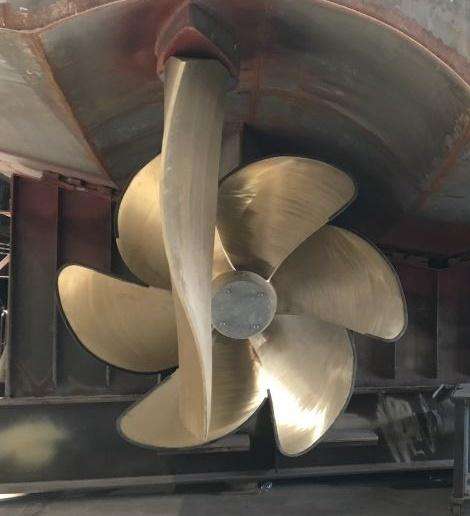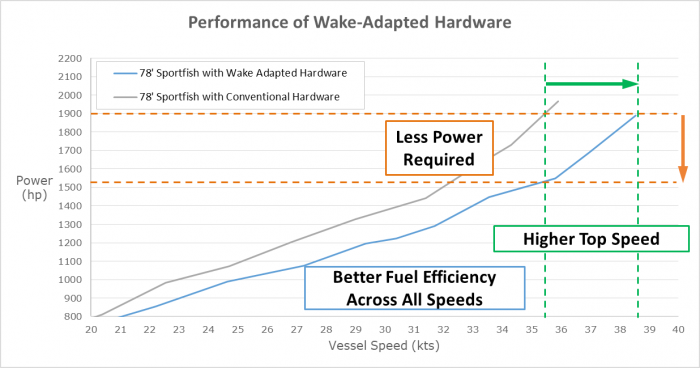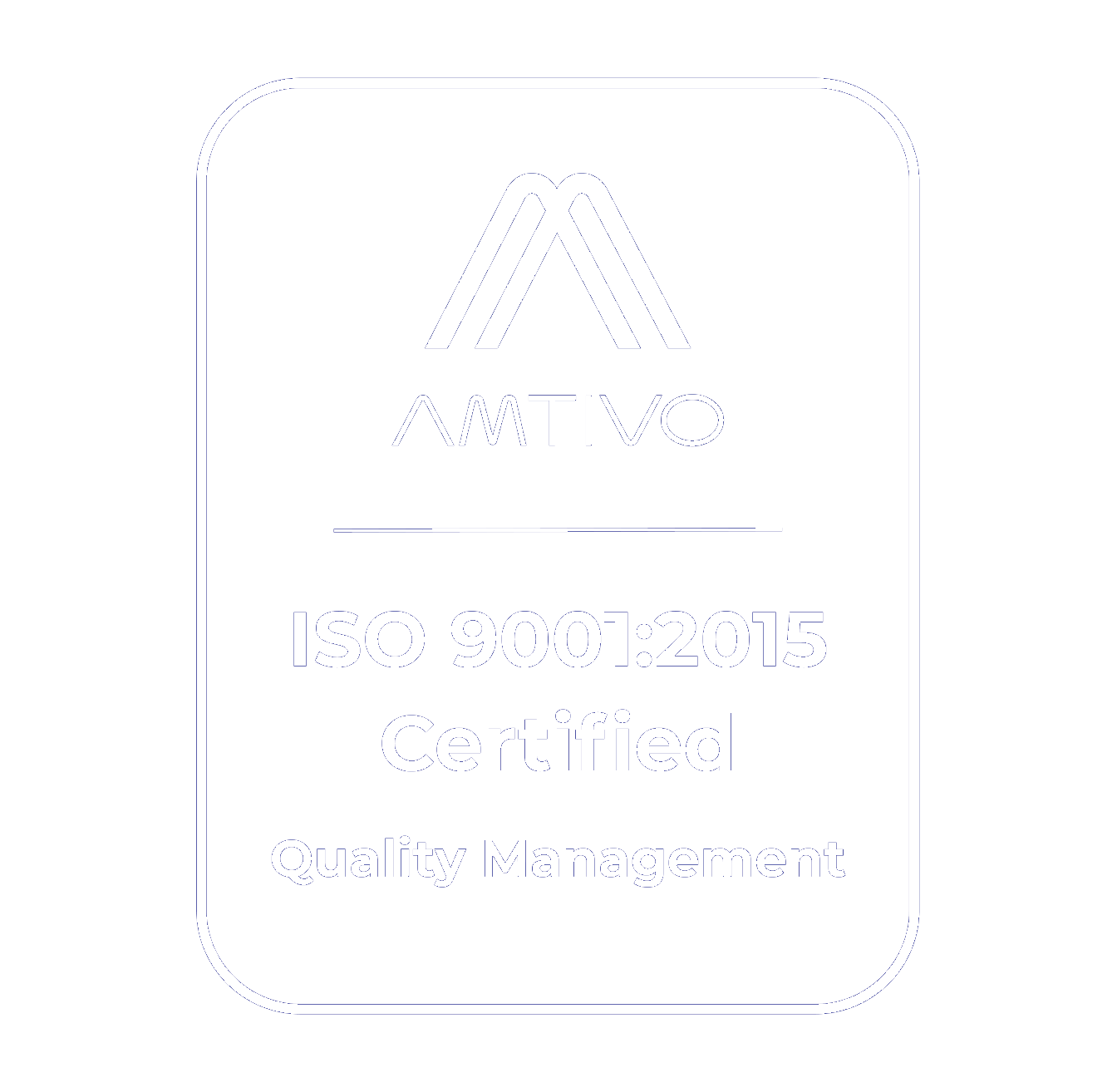Wake-Adapted Propellers, Struts, and Rudders
Here at Michigan Wheel, we often hear the question, how can I make my boat go faster? It can be tempting to respond, get a bigger engine, or take some weight off your boat, but we try to limit our responses to propeller related solutions. Sometimes, a simple change in pitch will help. Other times, a different diameter, or a different number of blades can make a difference. Our advanced propeller designs (CX and Marlin) really do increase top end speed. But there is another way that you can make a big impact on a boat’s performance: wake-adapted equipment.
Let’s start by defining the word “wake”. Wake is commonly used to describe the waves that propagate from a boat, but, in naval architecture terms, the wake is the whole region of water disturbed by a boat, including the water that is immediately underneath and behind the boat. This is where the propellers, struts and rudders operate. A piece of equipment is said to be “wake-adapted” when it is designed specifically to operate in the wake of a vessel. For example, a wake-adapted rudder often takes on a twisted shape allowing it to be better aligned with the flow of water coming out of the propeller.

The benefits of wake-adapted hardware are substantial: better speed, better fuel efficiency, and less noise and vibration. Let’s start with speed and fuel efficiency as these are tied together. Speed and fuel efficiency gains are made through two ways: reduction in drag, and increase in propulsive efficiency (how much thrust is developed by the propeller for a given amount of power, not to be confused with fuel efficiency). Drag, also called resistance, is the force that the propeller(s) must overcome to propel the boat forward. While most of a boat’s drag is a function of the shape and size of the hull, a significant portion is caused by appendages such as struts and rudders. Appendage drag is particularly important at high speeds. Because of their alignment with the wake, wake-adapted struts and rudders have significantly less drag than conventional equipment. This can have a major positive impact, reducing the overall drag of a vessel. If the overall drag of a vessel is reduced for a given speed, then the vessel can achieve that speed using less power. This is exactly what happens with wake-adapted struts and rudders.
Meanwhile, all three components (struts, rudders, and propellers) can contribute to gains in propulsive efficiency:
- A wake-adapted propeller can produce more thrust for a given amount of power
- A wake-adapted strut can improve the inflow of water to the propeller, increasing propeller efficiency
- A well designed, wake-adapted rudder can actually recapture some of the energy put into the water by the propeller and convert it into thrust
A gain in propulsive efficiency means that, for a given amount of power, the propeller produces more thrust, and the boat goes faster. Again, this is exactly what happens with wake-adapted equipment.
The combination of less drag and better propulsive efficiency means that, when compared to conventional equipment, a vessel with wake-adapted equipment requires less power at a given speed across a large range of speeds. Or, another way to look at it, a vessel with wake-adapted equipment can go faster for a given amount of power. Either way fuel efficiency is improved across a range of speeds.

Besides speed and fuel efficiency, wake-adapted equipment can also reduce noise and vibration. Propeller design can have a big impact on noise and vibration, and this is a huge area of study. One way to reduce vibration that applies both to propellers and rudders is through reduction in cavitation, which can be very noisy and destructive. Propellers and rudders often operate with some level of cavitation, especially at high speeds. By modifying the geometry of the rudder or propeller blade to better match the flow of water, we can drastically reduce the amount of cavitation and reduce the range of operation where cavitation occurs. Boat operators have described rudder post vibration as being “turned off” when switching from a conventional rudder to a wake-adapted rudder. While the speed and fuel efficiency gains are obviously important, some of our customers have stated that they would purchase wake-adapted equipment for the noise and vibration reduction alone. As you can see, the designs of the underwater hardware components can make a huge impact on a vessel’s performance.

Wake-adapted equipment designs have actually existed for many years. Traditionally, these designs were developed through model testing. Model test facilities manufacture scale models of vessels including propellers, struts, and rudders. Then they run these models down a long test tank, taking measurements and observing water flow around the appendages through various methods. Now, we use sophisticated computational fluid dynamics (CFD) modeling. We can simulate these same tests and more on supercomputers to predict vessel performance and evaluate potential designs. CFD simulations provide a number of benefits over model testing. One benefit is that we can evaluate the direction of water flow at any location in the simulation model. Another benefit is that we can run many configurations in a fraction of the time and at a fraction of the cost compared to model testing. Whenever we want to “test” changes to the original design, instead of making a new physical model, all we have to do is revise the 3D computer model. This allows us to narrow in on truly optimal designs.
Once we have settled on a final design, we move on to manufacturing. We manufacture most of our wake-adapted equipment at our headquarters in Grand Rapids, Michigan. All of our wake-adapted equipment is made of high strength Nickel-Aluminum Bronze (NiBrAl) material. NiBrAl is the most common high performance propeller material in use today. It is frequently used for struts and rudders where its strength and corrosion resistance properties make it an ideal metal alloy for the marine environment.
The complex shapes of wake-adapted hardware have forced us to develop innovative metal casting techniques. Once the casting is complete, we utilize full multi-axis CNC machining processes to finish the casting thus ensuring a high level of accuracy when compared to the computer design. Finally, we use 3D laser scanners to inspect the finished part, again ensuring accuracy to the design.

We have installed wake-adapted equipment on a wide range of vessels, including military patrol boats, coast guard boats, ferries, large yachts, sportfish boats, and cruisers, and we’ve received positive feedback on every application. Importantly, we’ve been able to verify our CFD predictions and the performance of our designs through full scale trials. Over and over again, wake-adapted equipment has shown significant improvements in speed, fuel efficiency, and noise & vibration when compared to conventional equipment.
Going back to our initial question – how can I make my boat go faster – hopefully it is obvious that wake-adapted equipment is a real option for increasing boat speed. Besides speed, it offers improved fuel efficiency and reduced noise & vibration. Wake-adapted systems, developed using sophisticated computational tools and advanced manufacturing techniques, may cost somewhat more than simplistic conventional systems. However, the wake-adapted system usually provides the best value because achieving the same increase in performance with conventional hardware will require either increasing engine size or running at lower speeds to achieve equivalent fuel efficiencies.
We hope you’ll consider Michigan Wheel wake-adapted equipment for your next boat, and we’d love to share more information with you!





